Microsoft MS-302 Microsoft 365 Teamwork Administrator Certification Transition Online Training
Microsoft MS-302 Online Training
The questions for MS-302 were last updated at Feb 20,2025.
- Exam Code: MS-302
- Exam Name: Microsoft 365 Teamwork Administrator Certification Transition
- Certification Provider: Microsoft
- Latest update: Feb 20,2025
Topic 1, Contoso Case Study
Overview
Existing Environment
Active Directory Environment
The network contains an on-premises Active Directory domain. All users are created in the domain and are organized units (OUs) the users use their domain credentials to sign in to their computer.
Microsoft Office 365 Environment
Contoso has a Microsoft Office 365 subscription and uses the following services:
– OneDrive for Business
– SharePoint Online
– Exchange Online
– Yammer
– Teams
Currently, the identity of each user is maintained separately in both on-premises Active Directory and Office 365.
Contoso implements SharePoint site collections for the following departments:
– Research & development -Human resources (HR)
– Marketing
– Finance -IT
Each department assigns a site owner to manage its site collection and to manage access. The site collection of each department contains multiple subsites. Sharing is allowed across different site collections by default.
External sharing is enabled for the organization.
Current Business Model
Contoso has the following business model:
– The HR department has a branded site collection
– Currently, the default storage limit is set for all the site collections
– The marketing department uses multiple site collections created by an administrator named Admin1
– Contoso has a strategic partnership with a company name Litware, Inc. Litware has an Office 365 subscription. All users at Litware have a user account in the litware.com domain
Problem Statements
Contoso identifies the following uses:
– Non-site owners invite external users to access the content in SharePoint Online
– Users upload audio, video, and executable program files to OneDrive for Business
– The company manages two separate identifies for each user, which creates more administrative work
– Users in the HR department report performance issues affecting their site collection. You suspect that the issues are due to large images on the home page
Technical Requirements
Contoso has the following technical requirements for the Office 365 environment:
– Add a Yammer feed to new communication sites
– Prevent non-site owners from inviting external users
– Troubleshoot the performance issues of the HR department site collection
– Increase a 100-GB storage limit for the site collection of the marketing department
– Prevent users from syncing media files, such as MP3 and MP4 files, from OneDrive
– Restrict users from sharing content from the finance department site collection to the Litware users
– Ensure that SharePoint administrators do not have administrative permissions to the site collections
– Ensure that the managers in the marketing department can view the storage metrics of the marketing department sites
– Maintain all user identities in on-premises Active Directory, Sync passwords to Microsoft Azure Active Directory (Azure AD)
– Ensure that when users are deleted from Microsoft 365, their associated OneDrive content is retained for 90 days. After 90 fays, the content must be deleted permanently
DRAG DROP
You need to meet the technical requirements for setting the storage limit.
Which three actions should you perform in sequence? To answer, move the appropriate actions from the list of actions to the answer area and arrange them in the correct order.


Explanation:
Scenario: Increase a 100-GB storage limit for the site collection of the marketing department
Step 1: From the SharePoint Admin center, select Settings
Step 2: Set Site Collection Storage Management to Manual
If you prefer to fine tune the storage space allocated to each site collection, you can set your storage management option to "manual" and specify individual site collection storage limits. In the left pane, under Admin centers, select SharePoint. If this opens the classic SharePoint
admin center, select Try it now to open the new SharePoint admin center.
Step 3: From site collections, configure the storage Quota.
Manage individual site collection storage limits
Follow these steps to specify individual site collection storage limits when your storage management option is set to "manual."
References: https://docs.microsoft.com/en-us/sharepoint/manage-site-collection-storage-limits
You need to meet the technical reQuirements for the finance department site collection.
What should you do?
- A . From the Security&Compliance admin center, create a permission policy
- B . From the SharePoint admin center, select Sharing, and then select Limit external sharing using domains
- C . From the Security&Compliance admin center, create a classification label policy
- D . From the SharePoint admin center, select the finance department site collection, and then configure the Share settings
B
Explanation:
Scenario: Restrict users from sharing content from the finance department site collection to the Litware users
References: https://docs.microsoft.com/en-us/sharepoint/restricted-domains-sharing
You need to confirm whether the performance issues experienced by the HR department site collection are due to the large image.
What should you do?
- A . From Site Settings for the site collection, select Storage Metrics
- B . From Site Settings for the site collection, select Site collection health checks
- C . From the Microsoft 365 admin center, view the service status of SharePoint Online
- D . From Microsoft Edge, open the site, Run the developer tools
D
Explanation:
Scenario: Users in the HR department report performance issues affecting their site collection. You suspect that the issues are due to large images on the home page
You can diagnose common issues with your SharePoint Online site using Internet Explorer developer tools.
There are three different ways that you can identify that a page on a SharePoint Online site has a performance problem with the customizations.
References: https://docs.microsoft.com/en-us/office365/enterprise/diagnosing-performance-issues-withsharepoint-online
DRAG DROP
You need to meet the site requirements for the marketing department managers.
Which three actions should you perform in sequence? To answer, move the appropriate actions from the list of actions to the answer area and arrange them in the correct order.
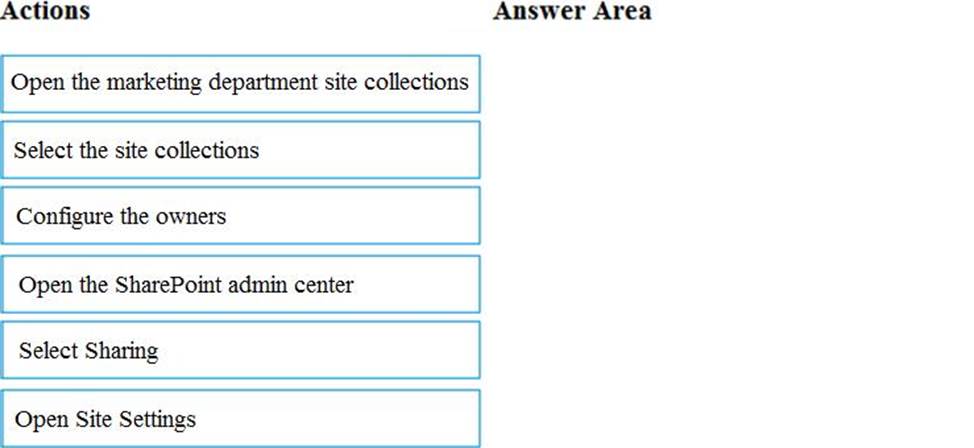
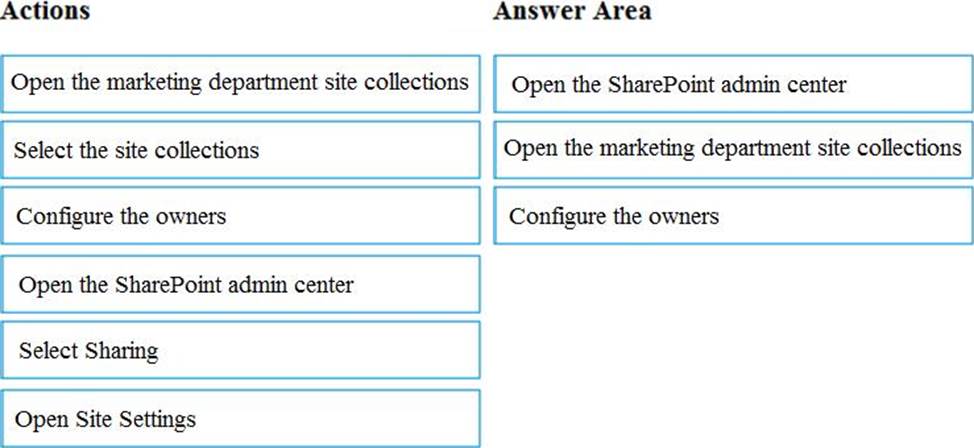
Topic 2, Litware Case Study
Overview
Existing Environment
On-premises Infrastructure
The network contains an Active Directory forest named litwareinc.com that contains a child domain for each region.
All domain controllers run Windows Server 2012. The main office sync identities to Microsoft Azure Active Directory (Azure AD) by using Azure AD Connect. All user accounts are created in the on-premises Active Directory and sync to Azure AD.
Each office contains the following servers and client computers:
– A domain controller that runs Windows Server 2012
– A file server that runs Windows Server 2012
– Client computers that run Windows 10
Currently, all content created by users is stored locally on file servers.
Cloud Infrastructure
Litware is moving the content from the file server to Microsoft Office 365. The company purchases 4, 500 Microsoft 365 E5 licenses. Litware uses Microsoft Exchange Online for email.
Problem Statements
Litware identifies the following issues:
– Finding content and people within the organization is difficult
– Users cannot access company data from outside the corporate network
– Content recovery is slow because all the content is still on-premises
– Data security is compromised because users can copy company content to USB drives
– The locally stored content is not classified as confidential and users can email documents to
external people
– Users must frequently contact the HR department to find employees within the organization who have relevant skills
– Users can delete content indiscriminately and without recourse as they have full control of the content on the file servers
Requirements
Business Goals
Litware identities the following strategic initiatives to remain competitive:
– All content must be stored centrally
– Access to content must be based on the user’s
– Users must be able to work on content offline
– Users must be able to share content externally
– Content must be accessible from mobile devices
– Content classifications must include a physical location
– Content must be retained and protected based on its type
– Litware must adhere to highly confidential regulatory standards that include:
– Users must be able to search for content and people across the entire organization
– Content classification metadata must adhere to naming conventions specified by the IT department
– Users must be able to access content quickly without having to review many pages of search results to find documents
– Security rules must be implemented so that user access can be revoked if a user share confidential content with external users
Planned Changes
Litware plans to implement the following changes:
– Move all department content to Microsoft SharePoint Online
– Move all user content to Microsoft OneDrive for Business
– Restrict user access based on location and device
Technical Requirements
Litware identifies the following technical requirements:
– All on-premises documents (approximately one million documents) must be migrated to the SharePoint document library of their respective department
– Each department must have its own term store group. Stakeholders must be notified when term sets are moved or deleted
– All the OneDrive content a user must be retained for a minimum of 180 days after the user has left the organization
– All external users must be added explicitly to Office 365 groups to give the users access to SharePoint team sites
– Office 365 groups must be used as the primary membership service for Microsoft Yammer, Teams, and SharePoint
– A user named Admin1 must be allowed to consume apps in the App Catalog and to add additional app licenses
– Viewers must be prevented from printing documents that are stored in a modern site named Finance
– Users must be prevented from printing content accessed in OneDrive form iOS and Android devices
– Retention, protection, and security policies must be implemented for all content stored online
– All offices must use the Managed Metadata Service to classify documents uploaded to SharePoint
– The Azure Information Protection client must be deployed to all domain-joined computers
– Searches must show results only when the result set is complete
– OneDrive must be used to work with documents offline
– Solutions must use the principle of least privilege whenever possible
You need to recommend a solution for the documents stored in the Finance site.
What should you recommend?
- A . Enable Azure Information Protection policy labeling
- B . For each library, enable sensitivity labeling that uses protection
- C . Enable an Information Rights Management (IRM) policy for the libraries
- D . From Settings in the SharePoint admin center, enable Information Rights Management (IRM) for SharePoint Online
B
Explanation:
Scenario: The locally stored content is not classified as confidential and users can email documents to external people
Apply Azure Information Protection to protect files in a highly confidential SharePoint Online team site. Configure Azure Information Protection with a new scoped policy and sub-label for protection and permissions of your highly confidential SharePoint Online team site.
Note: Details:
References: https://docs.microsoft.com/en-us/office365/securitycompliance/protect-sharepoint-online-files-withazure-information-protection
DRAG DROP
You need to configure the term store group to meet the requirements.
Which three actions should you perform in sequence? To answer, move the appropriate actions from the list of actions to the answer area and arrange them in the correct order.
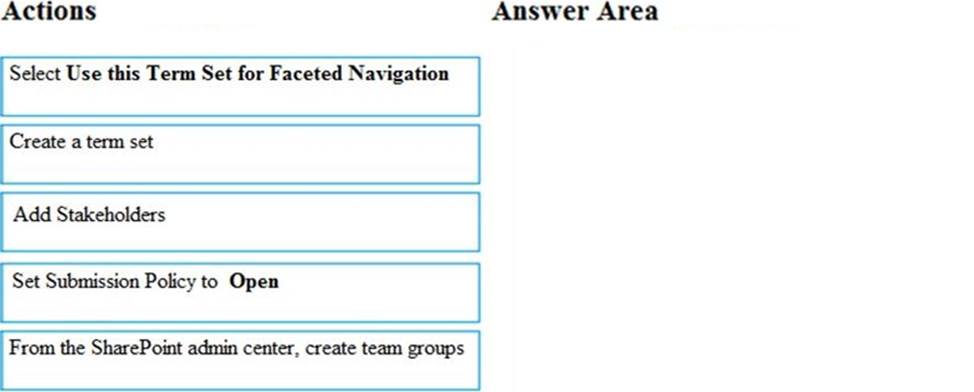
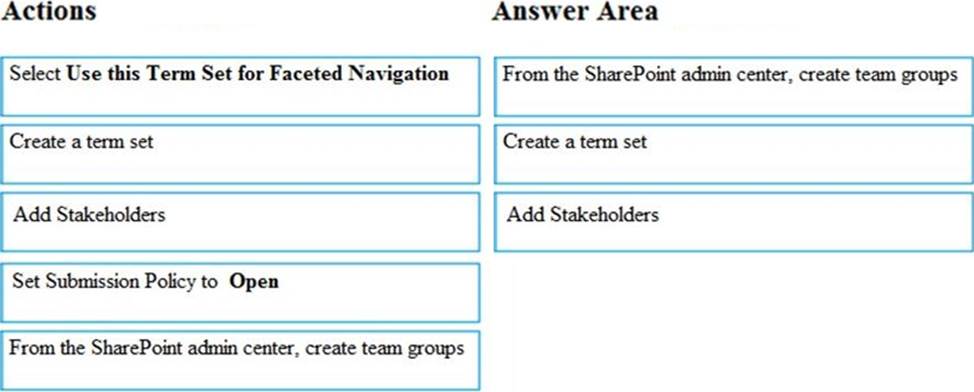
Explanation:
Scenario: Each department must have its own term store group. Stakeholders must be notified when term sets are moved or deleted
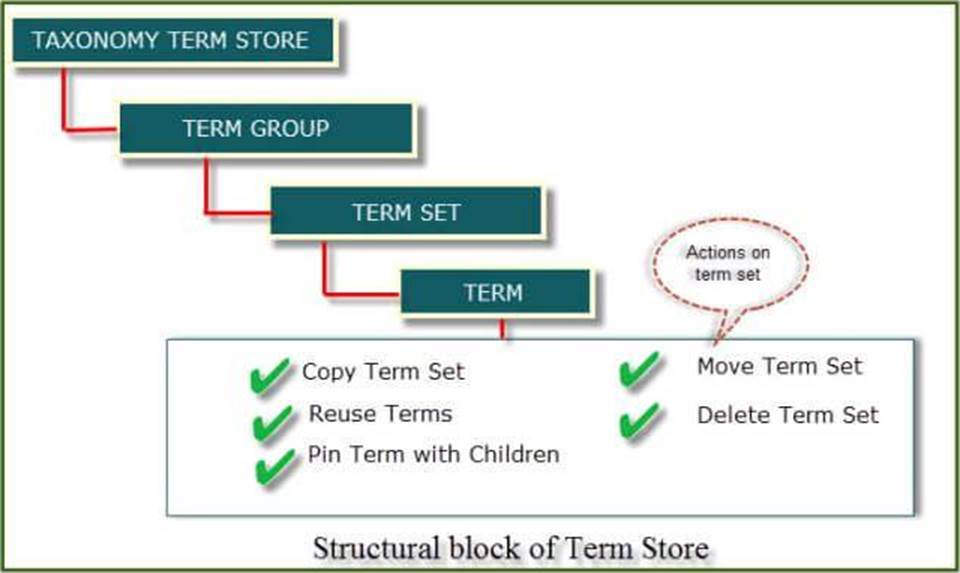
References: https://www.c-sharpcorner.com/article/introduction-of-term-store-management-in-sharepointonlineoffice-365/
You need to grant an external user guest access to the SharePoint site of the design department.
What should you do?
- A . From the SharePoint team site, modify the Members group
- B . From the SharePoint team site, modify the Visitors group
- C . From Microsoft Outlook, add a member to a group
A
Explanation:
References: https://docs.microsoft.com/en-us/microsoftteams/teams-dependencies
What should you configure to meet the licensing reQuirements for Admin1?
- A . Assign Admin1 the SharePoint administrator role
- B . Add Admin1 as a License Manager of the apps
- C . Add Admin1 to the site collection administrators of the App Catalog site
- D . Add Admin1 to the App Catalog site owners group of the App ReQuests list
D
Explanation:
Scenario: A user named Admin1 must be allowed to consume apps in the App Catalog and to add additional app licenses
By default, site owners can purchase and download apps from the SharePoint Store. When site owners reQuest an app for SharePoint from the SharePoint Store, they can reQuest a specific number of licenses and provide a justification for the purchase of the app for SharePoint. Submitted reQuests are added to the App ReQuests list in the App Catalog of the web application that contains a user’s site collection.
References: https://docs.microsoft.com/en-us/sharepoint/administration/manage-the-app-catalog
Topic 3, Misc. Questions
Note: This Question is part of a series of Questions that present the same scenario. Each Question in the series contains a uniQue solution that might meet the stated goals. Some Question sets might have more than one correct solution, while others might not have a correct solution.
After you answer a Question in this section, you will NOT be able to return to it. As a result, these
Questions will not appear in the review screen.
Your company has a Microsoft SharePoint Online subscription. The company purchases a new add-in for Microsoft Excel. You need to deploy the add-in to all users.
Solution: From the Microsoft 365 admin center, you deploy the add-in.
Does this meet this goal?
- A . Yes
- B . No
B
Explanation:
The plugin must be uploaded from the App Catalog, to the SharePoint asset library. Note: The SharePoint Add-ins catalog is a standard SharePoint asset library. Upload the add-in package to it using any of the methods of uploading files to SharePoint libraries. References: https://docs.microsoft.com/en-us/sharepoint/dev/sp-add-ins/deploy-and-install-a-sharepointhosted-sharepointadd-in
Note: This Question is part of a series of Questions that present the same scenario. Each Question in the series contains a uniQue solution that might meet the stated goals. Some Question sets might have more than one correct solution, while others might not have a correct solution.
After you answer a Question in this section, you will NOT be able to return to it. As a result, these
Questions will not appear in the review screen.
Your company has a Microsoft SharePoint Online subscription. The company purchases a new add-in for Microsoft Excel. You need to deploy the add-in to all users.
Solution: From the App Catalog, you upload the add-in to the Microsoft Office Add-ins
Does this meet this goal?
- A . Yes
- B . No
B
Explanation:
We should upload the add-in to the SharePoint Add-ins library, not the Microsoft Office Add-ins library. Note: The SharePoint Add-ins catalog is a standard SharePoint asset library. Upload the add-in package to it using any of the methods of uploading files to SharePoint libraries. References: https://docs.microsoft.com/en-us/sharepoint/dev/sp-add-ins/deploy-and-install-a-sharepointhosted-sharepointadd-in
Latest MS-302 Dumps Valid Version with 95 Q&As
Latest And Valid Q&A | Instant Download | Once Fail, Full Refund

